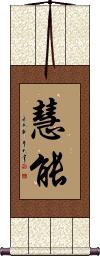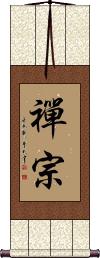Many custom options...
And formats...

Huineng in Chinese / Japanese...
Buy a Huineng calligraphy wall scroll here!
Personalize your custom “Huineng” project by clicking the button next to your favorite “Huineng” title below...
Huineng
Zen Buddhism
禪宗 is one way to title “Zen Buddhism.” Because the original pronunciation of Zen in Chinese is Chan, you'll also see this expressed as Chan Buddhism.
From the Buddhist Dictionary:
The Chan, meditative or intuitional, sect is usually said to have been established in China by Bodhidharma, the twenty-eighth patriarch, who brought the tradition of the Buddha-mind from India. This sect, believing in direct enlightenment, disregarded ritual and sūtras and depended upon the inner light and personal influence for the propagation of its tenets, founding itself on the esoteric tradition supposed to have been imparted to Kāśyapa by the Buddha, who indicated his meaning by plucking a flower without further explanation. Kāśyapa smiled in apprehension and is supposed to have passed on this mystic method to the patriarchs. The successor of Bodhidharma was 慧可 Huike, and he was succeeded by 僧璨 Sengcan, 道信 Daoxin, 弘忍 Hongren, 慧能 Huineng, and 神秀 Shenxiu, the sect dividing under the two latter into the southern and northern schools: the southern school became prominent, producing 南嶽 Nanyue and 靑原 Qingyuan, the former succeeded by 馬祖 Mazu, the latter by 石頭 Shitou. From Mazu's school arose the five later schools.
Not the results for Huineng that you were looking for?
Below are some entries from our dictionary that may match your Huineng search...
| Characters If shown, 2nd row is Simp. Chinese |
Pronunciation Romanization |
Simple Dictionary Definition |
寶林 宝林 see styles |
bǎo lín bao3 lin2 pao lin Hōrin |
More info & calligraphy: PaulineThe groves, or avenues of precious trees (in the Pure Land). The monastery of Huineng, sixth patriarch of the Chan sect, in 韶州典江縣 Dianjiang Xian, Shaozhou, Guangdong, cf. 慧 15. The 寶林傳 and supplement contain the teachings of this school. |
慧能 see styles |
huì néng hui4 neng2 hui neng enou / eno えのう |
More info & calligraphy: Huineng(person) Huineng (638-713) The power of wisdom. Huineng, name of a noted monk, sixth patriarch of the Intuitional or Meditation sect; died 713. |
禪宗 禅宗 see styles |
chán zōng chan2 zong1 ch`an tsung chan tsung Zenshū |
More info & calligraphy: Zen BuddhismThe Chan, meditative or intuitional, sect usually said to have been established in China by Bodhidharma, v. 達, the twenty-eighth patriarch, who brought the tradition of the Buddha-mind from India. Cf. 楞 13 Laṅkāvatāra sūtra. This sect, believing in direct enlightenment, disregarded ritual and sūtras and depended upon the inner light and personal influence for the propagation of its tenets, founding itself on the esoteric tradition supposed to have been imparted to Kāśyapa by the Buddha, who indicated his meaning by plucking a flower without further explanation. Kāśyapa smiled in apprehension and is supposed to have passed on this mystic method to the patriarchs. The successor of Bodhidharma was 慧可 Huike, and he was succeeded by 僧璨 Sengcan; 道信 Daoxin; 弘忍 Hongren; 慧能 Huineng, and 神秀 Shenxiu, the sect dividing under the two latter into the southern and northern schools: the southern school became prominent, producing 南嶽 Nanyue and 靑原 Qingyuan, the former succeeded by 馬祖 Mazu, the latter by 石頭 Shitou. From Mazu's school arose the five later schools, v. 禪門. |
七祖 see styles |
qī zǔ qi1 zu3 ch`i tsu chi tsu shichiso |
(1) The seven founders of the 華嚴 Huayan School, whose names are given as 馬鳴 Aśvaghoṣa, 龍樹 Nāgārjuna 杜順 (i.e. 法順) , Zhiyan 智儼, Fazang 法藏, Chengguan 澄觀 and Zongmi 宗密; (2) the seven founders of the 禪Chan School, i.e. 達磨 or 菩提達磨 Bodhidharma, Huike 慧可, Sengcan 僧璨, Daoxin 道信, Hongren 弘忍, Huineng 慧能 and Heze 荷澤 (or Shenhui 神曾); (3) The seven founders of the 淨土 Pure Land School, i.e. Nagarjuna, 世親 Vasubandhu, Tanluan 曇鸞, Daochuo 道綽, Shandao 善導, Yuanxin 源信 and Yuankong 源空 (or Faran 法然), whose teaching is contained in the Qizushengjiao 七祖聖教. |
六祖 see styles |
liù zǔ liu4 zu3 liu tsu rokuso |
The six patriarchs of the Ch'an (Zen) school 禪宗, who passed down robe and begging bowl in succession i. e. Bodhidharma, Huike, Sengcan, Daoxin, Hongren, and Huineng 達摩, 慧可, 僧璨, 道信, 弘忍, and 慧能. |
北宗 see styles |
běi zōng bei3 zong1 pei tsung kitamune きたむね |
(surname) Kitamune The northern school of the Chan (Zen) sect; from Bodhidharma 達磨 to the fifth patriarch 弘忍 Hongren the school was undivided; from 慧能 Huineng began the division of the southern school, 神秀 Shenxiu maintaining the northern; it was the southern school which prevailed. |
惠能 see styles |
huì néng hui4 neng2 hui neng Enō |
variant of 慧能[Hui4 neng2] Huineng |
曹溪 see styles |
cáo xī cao2 xi1 ts`ao hsi tsao hsi Sōkei |
Caoqi, a stream, south-east of Shaozhou, Guangdong, which gave its name to 慧能 Huineng. |
洞家 see styles |
dòng jiā dong4 jia1 tung chia horaie ほらいえ |
(surname) Horaie 洞上; 洞下 refer to the 曹洞 school of 慧能 Huineng. |
秀能 see styles |
xiù néng xiu4 neng2 hsiu neng Su Nō |
The two patriarchs 神秀 Shenxiu and 慧能 Huineng, q. v. |
盧行者 卢行者 see styles |
lú xíng zhě lu2 xing2 zhe3 lu hsing che Ro Anja |
Surname and title of 慧能 Huineng. |
五家七宗 see styles |
wǔ jiā qī zōng wu3 jia1 qi1 zong1 wu chia ch`i tsung wu chia chi tsung goke shichishū |
(五家) Division in China of the 禪 Ch'an, Intuitive or Meditative School. It divided into northern and southern schools under 神秀 Shenxiu and 慧能 Huineng respectively. The northern school continued as a unit, the southern divided into five or seven 宗, viz. 潙仰宗, 臨濟宗, 曹洞宗, 雲門宗, and 法眼宗; the two others are 黃龍 and 揚岐. |
大鑑禪師 大鑑禅师 see styles |
dà jiàn chán shī da4 jian4 chan2 shi1 ta chien ch`an shih ta chien chan shih Daikan zenji |
The great mirror, posthumous title of the sixth 禪 Chan (Zen) patriarch, 慧能 Huineng, imperially bestowed in A.D. 815. |
負舂居士 负舂居士 see styles |
fù chōng jū shì fu4 chong1 ju1 shi4 fu ch`ung chü shih fu chung chü shih fushō kyoshi |
layman of the pestle: Huineng |
The following table may be helpful for those studying Chinese or Japanese...
| Title | Characters | Romaji (Romanized Japanese) | Various forms of Romanized Chinese | |
| Huineng | 慧能 | huì néng hui4 neng2 hui neng huineng | hui | |
| Zen Buddhism | 禪宗 禅宗 | zen shuu / zenshuu / zen shu | chán zōng chan2 zong1 chan zong chanzong | ch`an tsung chantsung chan tsung |
| In some entries above you will see that characters have different versions above and below a line. In these cases, the characters above the line are Traditional Chinese, while the ones below are Simplified Chinese. | ||||
Successful Chinese Character and Japanese Kanji calligraphy searches within the last few hours...





